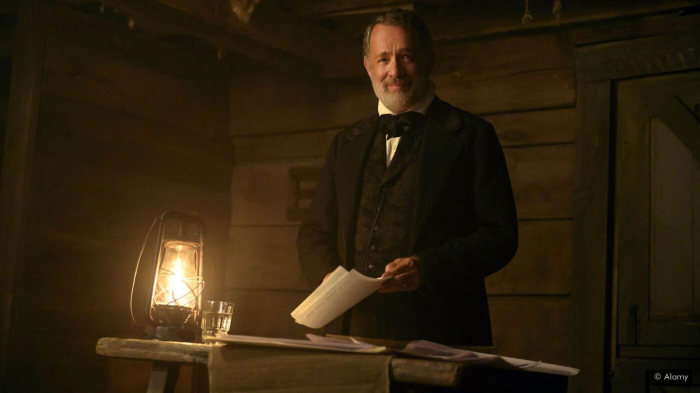Tom Hanks and Helena Zengel star in this "thoroughly engaging" adventure across Texas, which is "among the most beautiful films of the year," writes Caryn James.
Lovely is not the first word you'd usually associate with a Western, but it suits News of the World, a film with tenderness at its core despite its adventures and action. Tom Hanks gives a heartfelt but unsentimental performance as Captain Jefferson Kyle Kidd, a Confederate veteran of the US Civil War. He reluctantly takes a 10-year-old girl across Texas to her aunt and uncle, after she had been captured and raised for six years by a Kiowa tribe that murdered her parents.
The pairing of a Western codger and a young girl evokes John Ford’s 1956 classic, The Searchers. In that film, John Wayne’s character rescues his niece, who has been kidnapped by Comanches, preparing to reject her because she's no longer a respectable white girl. It also brings to mind True Grit, the 1969 original and the Coen brothers' witty 2010 version, in which a girl hires a US marshal to find her father's killer. But News of the World, which straightforwardly embraces the Western genre, is like The Searchers without the racist hero, True Grit without the wisecracks, and thoroughly engaging in its own right.
The film is set in 1870, as Kidd travels from town to town reading newspapers aloud to groups of people who drop coins in a bucket to hear him. Hanks has become especially good at suggesting what's hidden within a character, and he brings more to Kidd than the script – based on Paulette Jiles's 2016 novel – gives him to work with. Kidd's public readings feel deliberately rote, as he tells of a sunken ferry or a railroad line about to be extended. Hanks's tamped-down demeanour is less a sign of dullness than of a man who has buried his emotions and is haunted by the past.
Kidd’s inner life is also reflected in the film’s stunning visual style. Paul Greengrass, who directed Hanks in Captain Phillips, and cinematographer Dariusz Wolski create interiors with the dramatic contrasts of a Caravaggio painting: rooms of dark shadows, with bright lanterns shining here and there. The exterior scenes include wide, crystalline vistas of plains. It is among the most beautiful films of the year.
When Kidd takes to the road again, he finds the girl alone by a broken wagon and the hanged body of the agent who had been officially taking her home. He is a black man with a racist note pinned to his body, a fact that goes by so fast it's easy to miss. The dead man's papers say that the child's name is Johanna, but she seems not to remember that, or any language except Kiowa. The young German actress, Helena Zengel, is exceptional as Johanna, in a role that few actors of any age could manage as well. She has little dialogue, much of it subtitled until she learns a few words of English on her journey with Kidd. But her face and eyes are expressive, revealing wariness and fear and, we learn, sharp powers of observation. Johanna has a tendency to run away and in one scene is found by the river, looking across at a caravan of Native Americans. In a rare moment of emotion, she cries and yells to them, "Wait! Don't leave me!" More often she is restrained, her reserve a good match for Kidd's.
Greengrass chooses to emphasise action and let the characters' feelings stay largely in the background. In a rickety horse-drawn wagon, Kidd and Johanna travel through dusty towns and empty plains, on roads full of the kind of peril you'd expect from a Western. When three men in Dallas try to buy and then steal Johanna – villains we'd now call sex traffickers – Kidd races away with her, pursued by the men. They have a long shootout, with Kidd hiding behind rocks and the men trying to ambush him. There is a wagon disaster and a ferocious dust storm, the action handled with the velocity and immediacy that Greengrass brought to his Jason Bourne films.
Violence is everywhere, partly, as Kidd says, due to "Settlers killing Indians for their land. Indians killing settlers for taking it", and Civil War divisions between North and South in the towns Kidd visits. "The war is over. We have to stop fighting sometime," he says. But the film never delves too far into the period's social issues. Emphasising the action also slights the most original aspect of the plot: Kidd's profession. Jiles's novel makes a great deal of his role as storyteller, not just newsreader. He brings people accounts of hope and progress as well as disaster. The film merely nods in that intriguing direction.
Although the individual episodes are gripping, the plot trajectory is obvious, especially when we arrive at an ending that's easy to see from the start. But it works because there is something quietly miraculous about the way Hanks embodies this character, making him the stirring and fresh emotional centre of a beautifully old-fashioned Western.
More about: films
















































